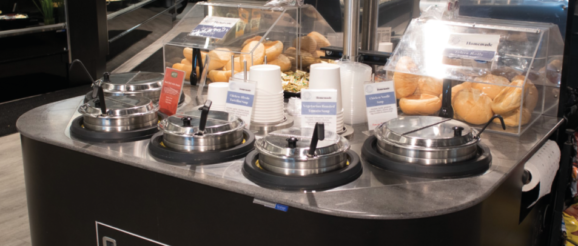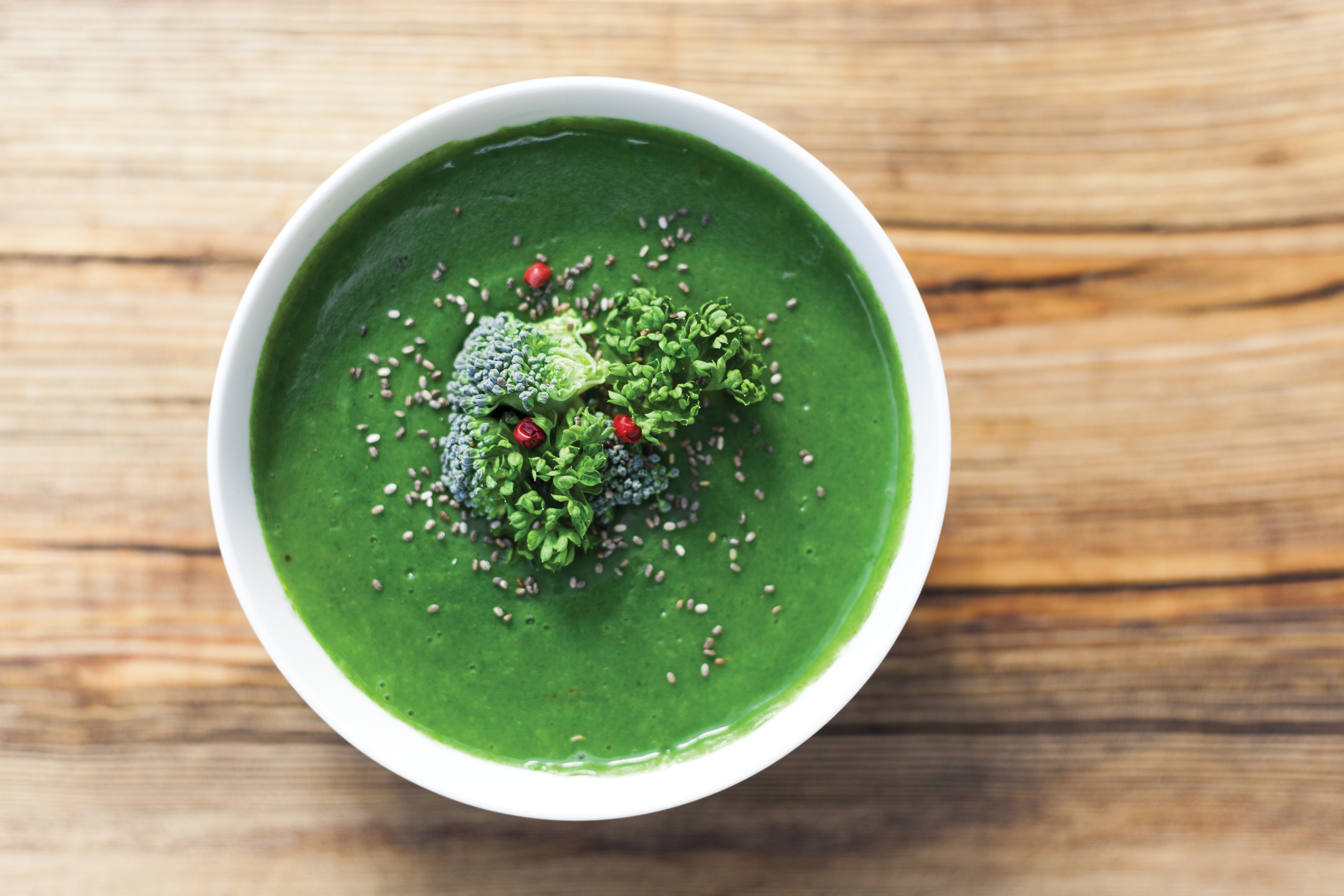Deli soup categories eye innovation as they get attention of younger Americans

During the cold winter months, nothing quite hits the spot like a hot cup of soup. In these times of convenience and grab-in-go, the category continues to hold steady. Predictions of growth in the global RTE market from Fact.MR, headquartered in the U.S. in Rockville, Maryland, show an estimated CAGR of 5.9% from 2017-2022. Other estimates predict a more modest CAGR of 2.9% from 2019-2024.
Versatile and convenient, light or hearty, soup is on target as a meal or lunch accompaniment, appetizer or snack, especially for Millennials and Gen Z who continue to buck three-square mealtime norms. Research from the College and University Soups and Sides Students Crave report conducted by Blount Fine Foods, Fall River, Massachusetts, depicts students seeking options that dovetail with flexitarian diets, foods with a story and convenience.
“Hot soup bars can be a great tool to introduce consumers to unique flavors and ingredients that otherwise might seem intimidating,” says Sandy Rega, vice president of marketing and sales planning, Kettle Cuisine, Lynn, Massachusetts. “It is also a great way to offer complete, satisfying meals representative of today’s food trends of simple, clean and nutrient-rich soups.”
Sixty-three percent of consumers take advantage of time-saving solutions for dinner with partially and fully prepared meals, according to the Washington, D.C.-based Food Marketing Institute. That makes ready-to-go soup, chowder, bisque, chili and stew options an easy accompaniment or a stand-alone option for a meal or snack. To cover a variety of eating patterns, delis can supply smaller-sized portions geared toward individuals and 1-2 person families as well as sizes for larger families and entertaining.
But a quick option doesn’t mean the offering shouldn’t also be memorable. Kettle Cuisine looks to captivate soup lovers with its handcrafted fresh and frozen RTU premium soup and broth concentrates for the deli hot soup bar and grab-and-go refrigerated cups. The company works with specially chosen purveyors in Pennsylvania, Montana, New Jersey, Texas, California, Vermont, Wisconsin and Colorado to supply meats, cheeses, vegetables and pasta for its wholesale products.
Rega shares IDDBA’s stat that 88% of shoppers desire more new items and flavors in grocery foodservice. Among those consumers, 31% want to see flavor and item rotation monthly, while 28% recommend a weekly or a daily rotation. IRI Scan Data shows Broccoli, Potato, Tomato and Chicken Noodle comprise nearly 60% of all refrigerated soup sales. Rega recommends supplementing these favorites with on-trend, seasonally and regionally specific flavors like Chicken Tortilla, Clam Chowder and Butternut Squash Bisque.
Ivar’s Soup & Sauce Company, Mulikteo, Washington, is anticipating meal planning needs while keeping things convenient for consumers, no matter the demographic. Ivar’s offers a range of best-selling chowders, bisques and soups, including its award-winning Puget Sound Style Clam Chowder. The prepared and frozen soups come in traditional meat-based options as well as vegetarian and allergen-conscious gluten- and dairy-free options.
What am I Eating?
Bisque – a thick, creamy sauce in the form of a puree. In French, bisque is a soup with shellfish. Early examples were made with game and poultry, not shellfish.
Chili – stew-like soup made with a combination of meat and/or vegetables, beans, chilies and chili powder.
Chowder – comes from the French word “cauldron,” meaning a cooking kettle. Typically, bisque is a combination of fish and/or vegetable stewed in a cauldron.
Soup – describes broth and a combination of meat, fish and/or vegetables. Soup is cooked in water or other liquid that is intended to be eaten. It can be thin, thick, chucky or smooth.
Stew – can describe any dish which uses a slow cooking process to tenderize tough pieces of meat. Typically includes meat and vegetables simmered in liquid for a substantial amount of time.
Sustainable and Sustaining
Considering soup’s longevity in the marketplace, it’s safe to consider it a sustainable option. In 2020, sustainability in all forms continues to top trend lists. This includes waste-reducing sustainability initiatives such as those predicted in Technomic’s 2020 trends report. Sustainability trends include environmentally conscious efforts such as using parts of food that might once have been considered kitchen waste including the greens from beets, leaves from sweet potatoes and avocado blossoms.
Creative use of surplus vegetables and meats can also be a way for instore deli kitchens to offer fresh soup options that dovetail with the trend of zero-waste cooking. The zero-waste movement continues to gain interest among those looking to combat the tons of usable meat, poultry and vegetables thrown away each year.
“For your high-volume signature soups (chili, chicken noodle, etc.) consider a larger soup well,” says Margie Proctor, design and marketing specialist, Dover Food Retail, Conyers, Georgia. “For additional soup offerings, consider smaller wells to reduce shrink and keep soups refreshed.”
Sandridge Foods, Medina, Ohio, is making sustainability a priority for its products and its employees. Its sustainability initiatives include energy and water conservation, reduction of waste through recycling and health and wellness improvements for its employees. Focused on the shifting demands of the dining public, Chef Dan Zakri creates hand-prepared soups, bisques, stews and chilis, including gluten-free, dairy-free and vegetarian options.
More Plants, Please
 Plans to increase intake of plant-based foods show no signs of losing momentum, showing up on the trend lists of Netherlands-based Innova Market Insights and Austin, Texas-based Whole Foods Market. Shifting palates and a desire to consume more plant-based foods make soup an ideal vehicle for increasing its appeal with more consumers, according to Eric Richard, education coordinator of the International Dairy Deli Bakery Association (IDDBA), Madison, Wisconsin. Because soups already feature a natural base of plants and/or meats, soup can add an easy health attribute that’s tasty, delicious and convenient.
Plans to increase intake of plant-based foods show no signs of losing momentum, showing up on the trend lists of Netherlands-based Innova Market Insights and Austin, Texas-based Whole Foods Market. Shifting palates and a desire to consume more plant-based foods make soup an ideal vehicle for increasing its appeal with more consumers, according to Eric Richard, education coordinator of the International Dairy Deli Bakery Association (IDDBA), Madison, Wisconsin. Because soups already feature a natural base of plants and/or meats, soup can add an easy health attribute that’s tasty, delicious and convenient.
“Soup is a great option to profile more plant-based ingredients in a familiar form,” Richard says. “It’s a way to engage consumers by emphasizing the benefits of a plant protein, specific nutrient or health attribute. Consumers are more concerned about what’s going in their body and they want to be educated.”
Peg Hamill, retail sales manager and foodservice sales and marketing executive at Ivar’s, echoes this sentiment. She recommends delis call out as much information about the soup as possible with options for a balanced nutritional lineup of protein, lower fats and salts being desirable. “I believe comfort foods like clam chowder, cheese broccoli, chicken noodle, pot roast and vegetable soup will always be popular,” Hamill continues. “Healthy, protein-forward, great-tasting, plant-based, gluten-free, vegan and vegetarian soups will also have a place.”
Offering a variety of soup and chili options for evolving consumer tastes is the norm for Blount Fine Foods. Its chili varieties include: Uncle Teddy’s Chunky Beef Chili (gluten-free), Turkey Chili (gluten- and dairy-free), Organic Vegetarian Chili (gluten-free, vegan, low-fat and Halal) and Beef Chili (gluten-free).
Expanded Spice Rack
For those who prefer their soup with a kick of spice, Blount Fine Foods offers Thai Chicken, Chicken Tortilla, Chicken Poblano, Chicken Enchilada, Kale Soup with Chourico, Southwest Corn, Chicken and Uncured Sausage Gumbo and Rip Roarin’ Crab & Corn soups. Blount Fine Foods research found that 38% of Millennials prefer ordering soup with spicy flavors, and younger consumers will visit a restaurant specifically for its soup.
But don’t think soup, chili and bisque featuring a hint of spice is just for the younger generations. Continued exploration into foreign cuisines and aging taste buds make the case for incorporating complex spices and flavors. Spice is not just for heat; it can also take the form of earthy, smoky, sweet, sour or fruity spice.
Today’s soups are the perfect vehicle for adding the earthy spice of curry powder, Cajun spice, jerk seasoning or gojuchang (Korean fermented chili paste). Or consider the addition of sour spicy with piri piri, harissa or a spoon of kimchi on the side. Spice can also get down-right hot with the addition of Aleppo, habanero or ghost peppers or wasabi can achieve a sweet spicy profile. Blount Fine Foods found 38% of consumers are willing to pay more for soups topped with high-quality garnishes.
Some might trace this love of spice to when sriracha hit the mainstream. Considered a “gateway” spice, sriracha opened a new sensory path surpassing the familiar smoky sweetness of barbecue sauce, smoked paprika, chipotle and poblano. Beyond sriracha, the growing popularity of Asian-inspired dishes along with flavors from Africa, the Middle East and Western Europe offer shoppers new soup varieties and garnishes incorporating chilies and chili-infused oils, peanuts, tamarind, ancient and exotic grains. New Food magazine predicts consumers will forego traditional pho for bún bò hue a Vietnamese soup made with rice vermicelli and beef.
Additions must also meet the expectations of health-conscious consumers who continue to look closely at ingredients and the use of preservatives. For some, this includes scrutiny of lower-fat substitutions and curbing the use of corn starch, which can increase blood sugar levels. In response to such demand, Cargill, Minneapolis, offers EZ Fill starches. Originally developed to meet the needs of the canning industry, EZ Fill starches can improve splashing, filling efficiency and fill-weight uniformity.
“Food trends have been surfacing at such a rapid pace these past 10 years and we find that it is only moving faster and faster,” Rega says. “To be successful, not only in the soup aisle but also in the store perimeter, the operator needs to have a finger on the pulse as to who their shopper is and what they are looking for in their local grocer. If you can satisfy the whole shopper experience, you can capture the loyalty of your shopper and increase their basket size with a strong foodservice offering.”
Soup Design Considerations
Source: Dover Food Retail
